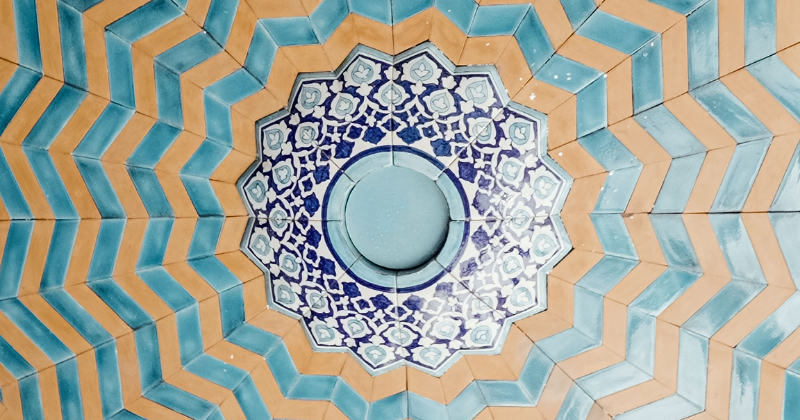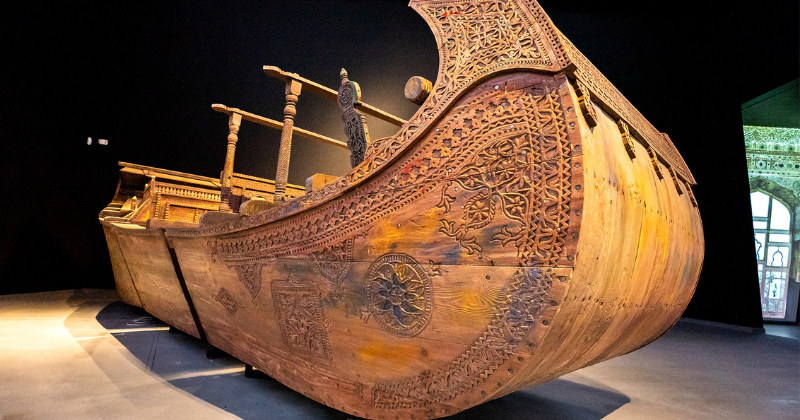"The Pakistan Pavilion has been a game-changer"
The Pakistan Pavilion at Expo 2020 Dubai continues to be a major attraction and has now seen over 100,000 visitors. The theme of the Pavilion ‘Pakistan – the Hidden Treasure’ was coined by Noorjehan Bilgrami, one of Pakistan’s most foremost visual artists, textile designers, researchers and educationists. It is also she who has curated the interior of the Pavilion.
Aurora spoke to Noorjehan Bilgrami about the conceptualisation of the ‘Inner Journey’ – the labyrinth-like interior of the Pavilion, which consists of eight spaces that pay tribute to the country’s diverse facets, be it its ancient civilisations, architectural heritage, ancient yet marginalised communities and religious diversity. She also speaks about her sources of inspiration for this project.
Mamun M. Adil: How did you come on board as the curator for the Pakistan Pavilion?
Noorjehan Bilgrami: Almost three years ago, I was invited to join a ‘core team’ formed by Shahid Abdulla, [the project lead of the Pavilion]. It was made up of various people from different disciplines. Perhaps, because I was doing more research work and writing down more ideas and taking more initiative than the others, I was invited to curate the Pavilion. It was a great opportunity and an honour for me to use 50 years of my experience to showcase the richness of Pakistan – be it our history, that spans thousands of years, or its culture, religious diversity and traditional crafts, in a meaningful and tangible manner that could change the perception people have of Pakistan.
MMA: What was the thought process behind the name of the Pavilion – ‘Pakistan – The Hidden Treasure’?
NB: Pakistan has unique jewels unknown to many, and so much to offer to people living in other countries – and even to Pakistanis who really do not know enough about their own country – so I thought we should call it something mysterious that would lure visitors. We went through hundreds of titles before agreeing to the title I had suggested, ‘Pakistan – The Hidden Treasure’. The narrative of the Pakistan Pavilion reflects – in a poetic way – the past, present and the future of the country – and the myriad lives that have helped its creation. As the interior of the building was designed like a labyrinth, I had to work with what I had. I designed eight spaces according to their peculiar sizes and shapes. I wanted to create a seamless journey as the Pavilion is designed in such a way that visitors have to enter from one point and leave from another without being able to turn around. I wanted to reach out to Pakistani craftspersons, filmmakers, artists and musicians and work with them to create a rich tapestry of our layered history and weave it together into a seamless journey.
MMA: How much emphasis was placed on creating a multimedia experience?
NB: Seventy percent of the experience consists of films. I was keen that visitors understand what Pakistan is about, and what better medium than film to do so? The first space, ‘Dawn of Civilisation’ centres on our ancient civilisations and pays homage to our past – something we usually overlook – as our history usually begins with Mohammad Bin Qasim and not Mehrgarh. We have a film that showcases Mehrgarh, Mohenjo Daro, Taxila, in addition to the Mughal and Sikh periods. The entrance door has hand-beaten copper triangles and a kashi tiled ceiling, designed by Sadia Salim which was made in Nasserpur by Ghulam Haider. Right across are replicas of pottery discovered in Mohenjo Daro and Harappa by Allah Ditta. A timeline by Naveed Sadiq has icons symbolising each era, painted in miniature style which traces our history from Mehrgarh (7000 BCE) to 1947.

MMA: Was the ceiling of Sheesh Mahal in Lahore Fort the inspiration behind the second space, ‘Sheesh Mahal: Pathway of Mirrors’?
NB: Yes, in addition to Surah-e-Noor from the Quran which is about light; it is absolutely beautiful and can be viewed in a calligraphic format on the wall. From here follows a corridor ‘Sheesha Kari - Pathway of mirrors’ crafted by Ustad Naqaash Rafaqat Ali (unfortunately he passed away after the installation reached Dubai from Lahore). It is a mesmerising experience created by light and mirror reflections. While researching how these mirrors are made, I discovered that there are two hidden factories in Shikarpur which manufactured convex mirrors by blowing glass. These mirrors are used in topis, embroidery and clothes. This is one of the jewels of Pakistan I discovered while creating the ‘Inner Journey’.

MMA: The largest room is ‘Haven of Natural Wonders’. What can visitors view there?
NB: We have very large screens that feature films directed by Nisar Malik depicting Pakistan’s breathtaking landscapes. In some cases, a helicopter was used to shoot the film. It provides a fabulous experience of Pakistan’s awe-inspiring landscapes, be they mountains, deserts, plains or rivers. Given the scale of the film, it makes viewers feel that they are reduced to a mere particle; a small screen showcases our wildlife, flora and fauna. Additionally, there are two installations, through which I pay homage to two ancient cultures.
MMA: They are?
NB: The first are the Mohanas [who lived in houseboats in Sindh, since the Moenjo Daro period on the Indus River – a terracotta seal has been used for this boat, which has been made by a team of craftsmen led by Ustad Muhammad Hussain Mughal and Mohammad Rahib Mirani in Sukkur using kail (ash wood) and sheesham (rosewood). I had to go through archival materials to find pictorial representations of the boat because they are no longer made, so it could be recreated. Working with the craftsmen was wonderful because of the sense of pride they have about their work. There was a lot of buzz in Sukkur about this boat that was recreated after 55 years. We documented the making of the boat in a short video. On the other side of the room is an installation centring on textiles, representing the Kalash living in the mountains of Northern Pakistan – again a marginalised but ancient community. The installation has pattu lengths (hand woven wool), kupas and shushut (headdresses) and jumolos, the dresses of Kohistani women.

MMA: From ‘Haven of Natural Wonders’, visitors move through a narrow corridor to ‘Sacred Spaces’ (Spaces four and five). What are the highlights?
NB: A dark passage leads the visitors to the heart of the Pavilion. After visitors walk under a red cloth canopy, they are greeted by the beating of drums and a whirling red robed dervish and a series of films directed by Jami that centre on the multiple religions practised in Pakistan. I wanted to showcase their existence, and emphasise the fact that we must preserve Pakistan’s mosques, shrines, temples, gurdwaras and churches. Light filters on the floor from a suspended carved wooden jaali. Another jaali was replicated from the tomb of Shah Rukn-e-Alam in Multan, and an exquisite panel inspired by the Wazir Khan Mosque in Lahore can be found in this space. Glistening against a dark background stand sculptural metal emblems by the artist Affan Baghpati There is also a brass bowl with water and rose petals; people think it is holy water! An antique red chaadar from a shrine can also be seen; the inclusion of simple elements are creating quite a stir.
MMA: Why do you think that is the case?
NB: I think people are used to walking through pavilions with AI and high-tech features and they tend not to feel they are part of it and do not experience tangible objects, films and fragrances. Visitors leave ‘Sacred Spaces’, intoxicated by the intensity of visuals, music, colours and the fragrance of roses via a bridge into the open air facing Rashid Rana’s spectacular facade and then step into space six – ‘Land of Opportunity’.
MMA: Why is it called so?
NB: It highlights the Government of Pakistan’s initiatives to attract investment. In the centre is a huge pink salt rock installation from the neglected, lesser known Khewra Salt Range in Punjab; a huge salt chunk can be seen with its minerals ‘levitating’ around it, and sits magnificently in a glass case. A dynamic film the contemporary Pakistan, highlights the country’s industries, education, women and youth.

Visitors then walk down a ramp to the seventh space –‘The Billion Tree Project, Reforesting Our Precious Land’ that emphasises initiatives in Pakistan that address climate change and issues related to sustainability. Laser beams add richness to the immersive experience. Visitors feel like they are travelling through the mangroves while on a boat, hearing the sounds of birds such as parrots, koels (cuckoos) and mainas (starlings) and the sound of lapping water. The last (eighth) space is dedicated to the ‘Craft Traditions of Pakistan’, which highlights the works of myriad craftsmen, from across Pakistan, be it ajrak in Sindh, naqqashi (a form of painting) in Punjab, mirror-making in Shikarpur, chitarkari (the art of engraving on schist stone) or jhandri (lacquer-work) in KPK. This done, visitors can go to the Bazaar where many of these handicrafts are on sale, or visit the Dhaaba (a restaurant), both of which have been designed by Naheed Mashooqullah.

MMA: If you did not have budgetary constraints, how would you have done things differently?
NB: I would have provided even richer and more interactive experiences and further focused on the pluralism of our country. Ultimately, though, despite the challenges, the Pakistan Pavilion has been a game-changer for the country’s image and has instilled pride in Pakistanis. I think it's time that the Government looks into supporting and bringing our past cultures and diversity to the fore and gives us more freedom to do so. It is time we respect and own what is ours – the past and the present, so our future can be progressive.
Photo courtesy: https://www.pakistanexpo2020.com/



Comments (34) Closed